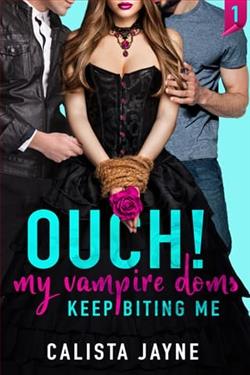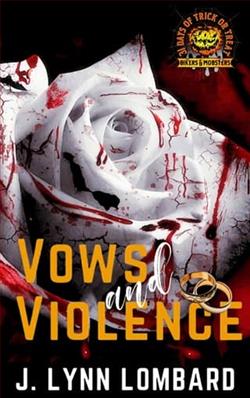Page 53 of Go Now
‘I’ve been looking at former Mayhew patients with connections to the New York metropolitan area,’ Chen said, urgently. ‘You really need to hear this…’
Meanwhile, back in the buggy, Coltrane offered Marcus some chewing gum. He took it.
‘Did you know, this area suffered a spate of witchcraft accusations, right at the end of the 17thcentury?’the Doctor said. ‘And in the Fifties, they damn near ran a Russian émigré out of town because they thought she was a communist spy.I don’t know what it is – maybe it’s all that wooded wilderness surrounding the town.Sets the mind a-wandering.’
‘You’re saying the townspeople are just paranoid?’
‘I’m saying that the fear can be more potent than the thing being feared. Annually, more people are killed by their own lawnmowers than they are by psychopaths.’
‘But do you have patients here who are psychopaths?’
‘Of course we do.But being a psychopath doesn’t mean someone is automatically going to be plotting violence against his or her fellow humans.A lot of them long to feel the emotions you and I do.And I don’t need to remind you that some people thrive very well as psychopaths, without ever troubling the justice system.Look at the Senate.’
Kate returned to them.There was a certain light in her eyes, a breathlessness that Marcus recognized.
‘Thomas Brennan,’ she said.
‘A good example of what I was talking about,’ the Doctor said, seemingly unsurprised by what she’d said.‘Thomas originally came as a secure patient. He now lives independently in the community, volunteers here in the arts and crafts unit, holds down two part-time jobs, one with the forestry corps, one working a few days a month in a relative’s sandwich business in Queens. In his case, medication and therapy obviously played a key role, but the real breakthrough was something nobody could have predicted.’
‘What was that?’
‘In 2017, we took a group of patients to the city to see the Museum of Modern Art.There was another exhibition showing just down the road. Tiny, shabby little space round the back of St.Pat’s.They were all sculptures by one artist – sort of leaping, dancing figures.Well, not figures, more abstract.Thomas was completely transfixed. He came back here, and he started making them. First of all, they were really just copies of what he'd seen in New York, clever, but still, just copies. Then he started making his own.They're very good. Kind of hypnotic… you know, you can't stop looking at them, even though they're very simple. I've got a couple in my office. I mean – they haven't changed Thomas's life, he's not a billionaire super-artist. But he… well, I suppose you could say he found his voice. Why do you mention him?'
‘Oh, I think someone in town mentioned he was one of your success stories.’
+ + + + + +
‘Someone in town mentioned he was one of your success stories.’
‘What’s the problem?The doc believed me.And I wasn’t about to announce that Brennan’s number one suspect in three murders.’
‘Why not?’
‘Because we could be wrong.We already messed up once, with James Caldwell.And you didn’t get hauled over the coals for that, just me.So I’d rather be cautious and do a bit of digging on the quiet.’
The little diner on Kampen’s Main Street had the modest, unassuming look that led outsiders like Kate and Marcus to expect miracles inside.In fact, the coffee was just okay, and the pancakes a little less so.Some diners looked middle-of-the-road because theyweremiddle-of-the-road.On the plus side, Kenny Rogers was on the jukebox, and they had a view of the cheery red bridge that spanned the Hudson, its waters turbulent after recent rains.
Kate had a photograph of Thomas Brennan’s Forestry Department ID on her phone.He was an unremarkable-looking man in his late thirties.Mid-brown hair, eyes somewhere between blue and gray, a little overweight, but not obese. They’d sent the image to David Sterling’s neighbor, Roy LaForge and he’d confirmed him as the man who rang his doorbell last week.
If they were right, Thomas Brennan possessed a talent for sculpture that was matched only by his brutality and ingenuity.He was a dangerous man, who had somehow convinced the world that he wasn’t.The world barely noticed him, and that, of course, was his greatest and deadliest skill.To walk amongst the ordinary people, breathing fire.
Marcus abandoned his forkful of pancake, and settled for a swig of coffee instead.
‘Remind me how he wound up at the Mayhew.’
‘He started attacking paintings in museums aged 15,’ Kate said. ‘Couldn’t explain his actions, just said he didn’t like them, they were “bad” and “wrong”. Juvenile social services appraised him shortly after his 16thbirthday – concluded that he had a high IQ combined with speech defects and some sort of schizotypal personality disorder. Whereabouts of parents unknown; he lived with an elderly relative in Queens. According to neighbors, granny sold religious tracts and mostly spent the money on cough syrup. But she seems to have belonged, originally, to some very strict type of Calvinist sect that thought pictures, paintings, all that sort of thing was sinful.’
‘That’s not all that unusual.Some groups interpret the ban on ‘graven images’ in the Second Commandment to mean anything that depicts any aspect of God’s creation. It’s also in line with some aspects of Jewish and Islamic theology.’
‘Thank you, Professor.Anyway, what we know for sure is that Brennan celebrated his 18thbirthday by stealing an Oldsmobile and driving it into the window of an uptown gallery. Again, stating only that he "didn't like pictures of stuff", "pictures made him mad" and suchlike. He seems to have drifted through his twenties in a repeating pattern: attacking artworks in museums, galleries, shops, along with petty crime and substance abuse, which landed him short prison sentences or probation.Basically, he kept falling between the cracks because he wasn't harming individuals, just art.Eventually, though, he set fire to an art gallery and wound up being hospitalized in the secure wing at the Mayhew in 2015. And, of course, as we know, he then had his own Road to Damascus moment, when he encountered the abstract work of Ray Blackstone at the New York gallery.'
‘I still can’t quite get my head around that,’ Marcus said.‘He’s got an almost religious dislike of paintings; well, it’s a fully religious dislike of paintings, you could say.But somehow, sculpture speaks his language.’
‘Well, he seems to have been a person who struggled to communicate.I’m just trying to imagine how frustrating, how maddening it would be, to be intelligent, to knowexactlywhat you thought and felt, but not be able to express it.He could only express himself through acts of anger and destruction, which of course, gets him into trouble.’
Marcus nodded.‘But then, along comes sculpture.’
‘Which simplifies everything for him.It’s beyond words. And people praise him for it, instead of locking him up.’















